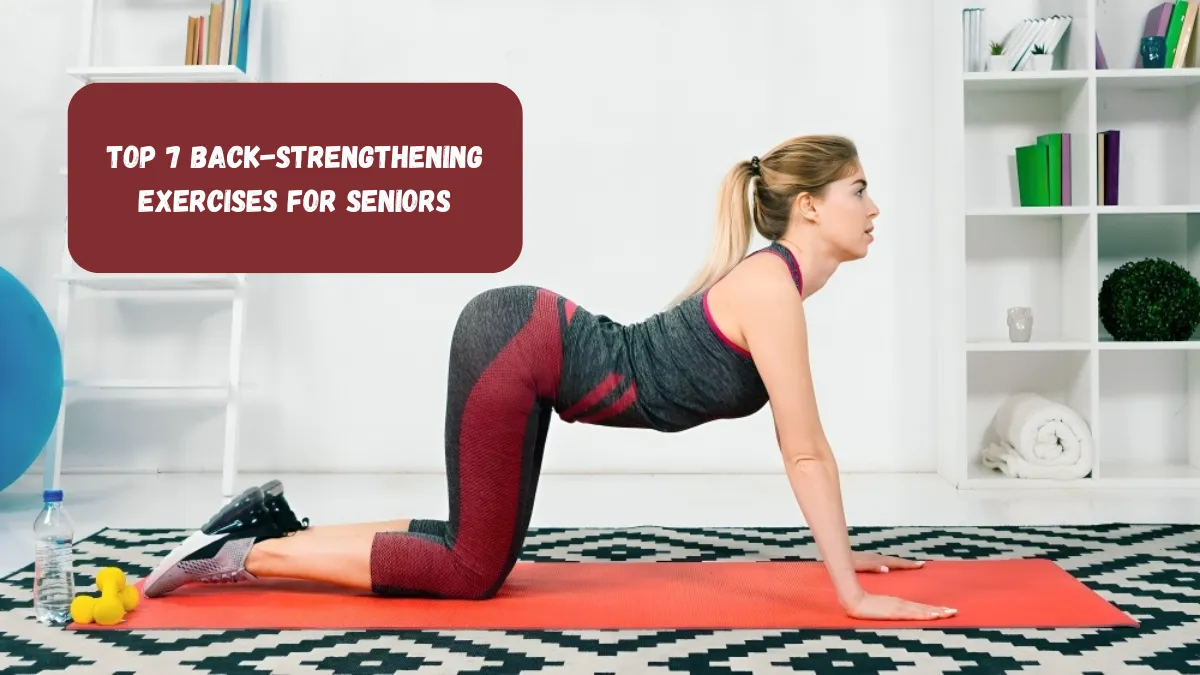Back-Strengthening Exercises for Older People – As we get older, many of us deal with lower back pain, but it doesn’t have to control your daily life. You can strengthen your back, improve your balance, and make it easier to move around if you do the right exercises.
This will also help you feel better and avoid future problems. As an expert in active aging, Dr. Lisa Carter says, “The key is consistency and focusing on movements that support joint health and core stability.” “Strengthening your back isn’t just about getting rid of pain; it’s also about staying active, independent, and sure of yourself.”
Here are seven routines that are safe, good for you, and made just for adults. These moves work your core, back muscles, and balance, which makes you stronger and makes you feel better. Let’s begin; your better, pain-free self is ready!
1. Pelvic Tilts
Pelvic tilts are an easy exercise that can help relieve stress in your lower back and build muscle in your core. Lay on your back with your knees bent and your feet flat on the floor, hip-width apart. Put your hands next to each other with the palms facing down. Hold for two to three seconds before letting go. Tilt your hips up a little and press your lower back flat against the floor.
Do this 10–15 times, making sure to breathe deeply each time. A physical therapist named Dr. Lisa Carter says this move helps loosen up your lower back while working your core. Instead of bending your back too much, move slowly and focus on using your core muscles. This should be relaxing, not hard, which makes it great for newbies.
2. Cat-Cow Stretch
The cat-cow stretch is a yoga-inspired move that makes the spine more flexible, eases stiffness, and helps you relax. As if you were sitting at a table, put your hands and knees under your shoulders and your knees under your hips to start. Take a deep breath in as you bend your back, lowering your belly to the floor, and raise your head and tailbone (Cow Pose).
Cat Pose: Let out a breath as you round your back, tuck your chin to your chest, and pull your belly button toward your spine. For 6 to 8 slow, controlled breaths, switch between the two poses. Dr. Carter says that this stretch helps keep the back flexible and loose. Focus on the flow of your breath to get the most out of your moves. Also, don’t overextend your neck or lower back.
3. Bird-Dog
The bird-dog exercise is great for keeping you from getting hurt because it strengthens your core and lower back and improves your balance and agility. Start by getting down on your hands and knees like you’re at a table. Keep your body straight and steady as you extend your right arm forward and your left leg backward.
Held for two to three seconds, then went back to the beginning and switched sides. Do eight to ten reps on each side. Dr. Carter says, “This move tests your balance while keeping your spine straight.” Keep your back flat and your core tight. Don’t let your hips tilt or sag. If you have trouble keeping your balance, spread out only one limb at a time to boost your confidence.
4. Wall Angels
Wall angels are a great way to improve the muscles that support good posture. This will help you avoid slouching and slumped shoulders. Place your back against a wall and your feet about 6 inches from the base.
Kindly press your head, lower back, and upper back against the wall. To make a “W” shape, bend your elbows 90 degrees. Then, slowly slide your arms up the wall into a “Y” shape, and then go back to the beginning.
Make sure your back stays against the wall the whole time as you do 8–12 reps. Dr. Carter says, “This move changes your posture and strengthens key stabilizing muscles.” If pushing your lower back flat against the wall hurts, don’t do it. Instead, keep the natural curve and focus on making slow, controlled moves.
5. Glute Bridges
You work out your hips, hamstrings, and lower back with glute bridges. They strengthen your spine and relieve stress. Lay on your back with your feet hip-width apart and your knees bent. Push through your feet to lift your hips up toward the sky. At the top, squeeze your glutes.
Carefully bring your hips back down. Hold each lift for two to three seconds for 10 to 15 times. Dr. Carter says, “Strong glutes are very important for lowering back pain.” To protect your spine, don’t arch your lower back too much. Instead, work on tightening your core and working your hips.
6. Seated Forward Fold
The sitting forward fold is a relaxing stretch that lengthens your spine, loosens up your hips, and releases pressure in your lower back. Place both feet flat on the ground and sit down in a chair. Fold forward a little and hinge at the hips. Rest your hands on your legs or knees.
Hold the stretch for 15 to 30 seconds, and then stand back up. Do this 3–5 times, and each time, take deep breaths as you stretch. Dr. Carter says, “This move helps relieve tension and promotes better alignment.” Keep your back straight and don’t round too much. If the fold is too deep for your flexibility, you can make it less painful.
7. Side-Lying Leg Lifts
Side-lying leg lifts work the abductors of your hips, which are very important for keeping your spine stable and supporting your lower back. Put your legs together and lie on your side. Rest your head on a pillow or your bottom arm. Keep your top leg straight as you lift it toward the sky and then slowly lower it back down.
Do 10–12 reps on each side, then switch sides. Dr. Carter says, “Strong hips are necessary to avoid lower back pain.” Do not move your hips forward or backward; instead, stack them and keep them firm. To get stronger without putting too much stress on your joints, focus on moves that are smooth and controlled.




